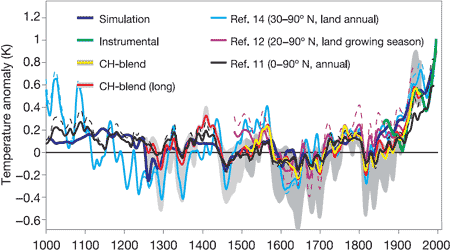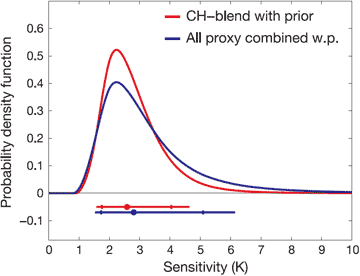
If there's one thing that all sides of the climate debate can agree on, it's that climate has changed naturally in the past. Long before industrial times, the planet underwent many warming and cooling periods. This has led some to conclude that if global temperatures changed naturally in the past, long before SUVs and plasma TVs, nature must be the cause of current global warming. Ironically, this conclusion is the opposite to what peer reviewed science has found.
Our climate is governed by a simple principle. When the planet has an energy imbalance, global temperature changes. Say the planet is in positive energy imbalance. More energy is coming in than going out. The planet accumulates heat and global temperature gradually rises (not monotonically, of course, internal variability will add noise to the signal). Eventually, the planet returns to equilibrium at a higher temperature. The key question is how much does temperature change for a given change in heat content. This is determined by the planet's climate sensitivity. The change in global temperature can be expressed by the following equation:

DT is the change in global temperature. RF is the radiative forcing, the change in net energy flow at the top of the atmosphere. This might be due to the sun getting brighter. Or a volcanic eruption spewing sulfate aerosols into the atmosphere, reflecting sunlight and letting less energy in. When radiative forcing RF is positive, it means the planet is accumulating heat. Lastly, l is the climate sensitivity parameter. This is a measure of how sensitive our climate is to changes in our climate's heat content.
The most common way of describing climate sensitivity is how much global temperature would change if CO2 is doubled. What does this mean? This is not to say CO2 is the only driver of climate. The amount of energy absorbed by the extra CO2 is calculated using line-by-line radiative transfer codes. These results have been experimentally confirmed by satellite and surface measurements. The radiative forcing from a doubling of CO2 is 3.7 Wm-2 (IPCC AR4 Section 2.3.1). So when we talk about the climate sensitivity to doubled CO2, specifically, we're talking about how much global temperatures would change when the climate experiences a radiative forcing of 3.7 Wm-2.
What is the result from a radiative forcing of 3.7 Wm-2? If we lived in a climate with no feedbacks, global temperatures would rise 1.2°C (Lorius 1990). However, our climate has feedbacks, both positive and negative. The most dominant positive feedback is water vapour - as temperature rises, so too does the amount of water vapour in the atmosphere. However, water vapour is a greenhouse gas which causes more warming which leads to more water vapour and so on. There are also negative feedbacks - more water vapour in the air can cause more clouds which reflects incoming sunlight, resulting in a cooling effect.
So what is the net feedback? We can calculate climate sensitivity from empirical measurements. One needs to find a period where we have temperature records and determinations of the various climate forcings that drove the climate change. If we can measure the change in temperature DT and the radiative forcing RF, climate sensitivity l can be calculated.
Hansen 1993 is one of the earlier determinations of climate sensitivity, examining the period when the Earth fell into the last major ice age. They calculated the change in Earth's albedo due to growing ice sheets. Ice core measurements yielded falling levels of greenhouse gases and increased atmospheric aerosols. From the surface and atmospheric changes, they were able to calculate a net radiative forcing. Coupling this with the temperature record, they found climate sensitivity to be 3 ± 1°C for a doubling of CO2. This means our climate has net positive feedback.
Over the last 1000 years, we've experienced climate change such as the Medieval Warm Period around AD 800-1300. This was followed by the Little Ice Age, roughly spanning the 16th century to the mid 19th century. Hegerl 2006 looks at Northern Hemisphere temperatures spanning both periods, using 4 different temperature reconstructions.

Figure 1: 4 different palaeoclimatic records over the past 1000 years (Hegerl 2006).
They calculate forcing from solar variations, volcanic activity and greenhouse gas forcing. They find a climate sensitivity range of 1.5 to 6.2°C, with the most likely value around 2.6°C. Again, confirmation of net positive feedback.

Figure 2: Probability density functions (PDFs) for equilibrium climate sensitivity to CO2 doubling (in K). Combined estimate using a result from instrumental data as prior distribution.
Hegerl found the temperature record with the most variety yielded the greatest climate sensitivity. And thus we come to the great irony in the argument that past climate change proves humans can't change global temperatures now.
CO2 has caused an accumulation of heat in our climate. We know the radiative forcing from CO2, confirmed by empirical observations. The effect of this heat build-up on global temperatures is determined by climate sensitivity. The greater climate has changed in the past, the greater the climate sensitivity.
Ironically, when skeptics cite past climate change, they're in fact invoking evidence for climate sensitivity and net positive feedback. Higher climate sensitivity means a larger climate response to CO2 forcing. Past climate change is actually evidence that humans can affect climate now.
Posted by John Cook on Wednesday, 21 October, 2009
 |
The Skeptical Science website by Skeptical Science is licensed under a Creative Commons Attribution 3.0 Unported License. |